A Data-Driven Framework for Modeling Car-Following Behavior Using Conditional Transfer Entropy and Dynamic Mode Decomposition
Abstract
1. Introduction
2. Methods
2.1. Traffic Models
2.1.1. Backward-Looking Effect and Motion Information (BLMI) Model
2.1.2. Hybrid Traffic Model
- Optimal Velocity Model (OVM)
- Intelligent Driver Model (IDM)
2.2. Description of Observational Data
2.3. Control Input Identification via Transfer Entropy
2.4. System Identification and Prediction Using Dynamic Mode Decomposition with Control
| Algorithm 1 Dynamic mode decomposition with control (DMDc). |
| Input: Data snapshots of system states , next-step states , control inputs , where T is the total number of time steps. Output: Approximated system matrices and such that:
|
2.5. Metrics
- Mean Relative Error (MRE):
- Mean Square Error (MSE):
- Collision Rate:
3. Results and Discussion
3.1. Results of Control Input Identification via Transfer Entropy
3.2. Car-Following Model Estimation Using DMDc
3.2.1. DMDc-Based Model Estimation on Simulated Data
3.2.2. Interpreting the DMDc-Estimated Dynamics
- Case 1:
- Case 2:
- Case 3:
- Case 4:
3.3. DMDc-Based Model Estimation and Prediction Using Real-World Traffic Data
Temporal Evolution of Prediction Error
4. Conclusions and Future Work
Author Contributions
Funding
Data Availability Statement
Conflicts of Interest
References
- Xiong, Z.; Hu, P.; Li, N.; Chen, X.; Chen, W.; Wang, H.; Xie, N.; Li, Y.; Dong, C. Modelling and simulation of mixed traffic flow with dedicated lanes for connected automated vehicles. Expert Syst. Appl. 2025, 274, 127027. [Google Scholar] [CrossRef]
- Avila, A.M.; Mezić, I. Data-driven analysis and forecasting of highway traffic dynamics. Nat. Commun. 2020, 11, 2090. [Google Scholar] [CrossRef] [PubMed]
- Han, J.; Karbowski, D.; Kim, N.; Rousseau, A. Human Driver Modeling Based on Analytical Optimal Solutions: Stopping Behaviors at the Intersections. ASME Lett. Dyn. Syst. Control 2020, 1, 1–8. [Google Scholar]
- Treiber, M.; Kesting, A. An Open-Source Microscopic Traffic Simulator. IEEE Intell. Transp. Syst. Mag. 2010, 2, 6–13. [Google Scholar] [CrossRef]
- Bando, M.; Hasebe, K.; Nakayama, A.; Shibata, A.; Sugiyama, Y. Dynamical model of traffic congestion and numerical simulation. Phys. Rev. E 1995, 51, 1035–1042. [Google Scholar] [CrossRef]
- Treiber, M.; Hennecke, A.; Helbing, D. Congested traffic states in empirical observations and microscopic simulations. Phys. Rev. E 2000, 62, 1805–1824. [Google Scholar] [CrossRef]
- Ma, M.; Wang, W.; Liang, S.; Xiao, J.; Wu, C. Improved Car-Following Model for Connected Vehicles Considering Backward-Looking Effect and Motion Information of Multiple Vehicles. J. Transp. Eng. Part A Syst. 2023, 149, 04022148. [Google Scholar] [CrossRef]
- Han, J.; Wang, X.; Wang, J.; Shen, C.; Chen, T. Stability Analysis of an Extended Car-Following Model with Consideration of the Surrounding Leading Vehicles and the Rear Vehicle. Appl. Sci. 2025, 15, 4157. [Google Scholar] [CrossRef]
- Al Habboush, S.; Yildiz, Y.; Annaswamy, A.M. Human-Inspired Learning for Car Following Models. IFAC-PapersOnLine 2024, 58, 224–229. [Google Scholar] [CrossRef]
- Yang, Z.; Jerath, K. Energy-based Data Sampling for Traffic Prediction with Small Training Datasets. IFAC-PapersOnLine 2024, 58, 738–743. [Google Scholar] [CrossRef]
- Chen, X.; Zhu, M.; Chen, K.; Wang, P.; Lu, H.; Zhong, H.; Han, X.; Wang, X.; Wang, Y. FollowNet: A Comprehensive Benchmark for Car-Following Behavior Modeling. Sci. Data 2023, 10, 828. [Google Scholar] [CrossRef]
- Liu, Y.; Lyu, C.; Zhang, Y.; Liu, Z.; Yu, W.; Qu, X. DeepTSP: Deep traffic state prediction model based on large-scale empirical data. Commun. Transp. Res. 2021, 1, 100012. [Google Scholar] [CrossRef]
- Afshari, A.; Lee, J.; Besenski, D.; Dimitrijevic, B.; Spasovic, L. Calibrating Microscopic Traffic Simulation Model Using Connected Vehicle Data and Genetic Algorithm. Appl. Sci. 2025, 15, 1496. [Google Scholar] [CrossRef]
- Shi, Y.; Wu, T.; Guo, T.; Huo, J.; Gu, Z.; Dai, Y.; Liu, Z. Traffic simulation optimization considering driving styles. Commun. Transp. Res. 2025, 5, 100181. [Google Scholar] [CrossRef]
- Panwai, S.; Dia, H. Neural agent car-following models. IEEE Trans. Intell. Transp. Syst. 2007, 8, 60–70. [Google Scholar] [CrossRef]
- Lane, D.; Roy, S. Validating a data-driven framework for vehicular traffic modeling. J. Phys. Complex. 2024, 5, 025008. [Google Scholar] [CrossRef]
- Ramlall, P.; Roy, S. Determining critical vehicle connectivity in connected autonomous vehicles using information theory. IFAC-PapersOnLine 2024, 58, 995–1000. [Google Scholar] [CrossRef]
- Bishnu, S.K.; Alnouri, S.Y.; Al-Mohannadi, D.M. Computational applications using data driven modeling in process Systems: A review. Digit. Chem. Eng. 2023, 8, 100111. [Google Scholar] [CrossRef]
- Habib, M.; Ayankoso, S.; Nagata, F. Data-Driven Modeling: Concept, Techniques, Challenges and a Case Study. In Proceedings of the 2021 IEEE International Conference on Mechatronics and Automation (ICMA), Takamatsu, Japan, 8–11 August 2021; pp. 1000–1007. [Google Scholar]
- Solomatine, D.; See, L.; Abrahart, R. Data-Driven Modelling: Concepts, Approaches and Experiences. In Practical Hydroinformatics: Computational Intelligence and Technological Developments in Water Applications; Springer: Berlin/Heidelberg, Germany, 2008; Chapter 2; pp. 17–30. [Google Scholar]
- Benner, P.; Breiten, T.; Faßbender, H.; Hinze, M.; Stykel, T.; Zimmermann, R. Model Reduction of Complex Dynamical Systems; Springer: Berlin/Heidelberg, Germany, 2021. [Google Scholar]
- Yang, Z.; Jerath, K. Examining the Observability of Emergent Behavior as a Function of Reduced Model Order. In Proceedings of the 2018 Annual American Control Conference (ACC), Milwaukee, WI, USA, 27–29 June 2018; pp. 6218–6223. [Google Scholar]
- Schmid, P.J. Dynamic Mode Decomposition and Its Variants. Annu. Rev. Fluid Mech. 2022, 54, 225–254. [Google Scholar] [CrossRef]
- Colbrook, M.J. The multiverse of dynamic mode decomposition algorithms. In Numerical Analysis Meets Machine Learning; Handbook of Numerical Analysis; Mishra, S., Townsend, A., Eds.; Elsevier: Amsterdam, The Netherlands, 2024; Volume 25, pp. 127–230. [Google Scholar]
- Li, D.; Zhao, B.; Lu, S.; Wang, J. A data-driven method for fast predicting the long-term hydrodynamics of gas–solid flows: Optimized dynamic mode decomposition with control. Phys. Fluids 2024, 36, 103332. [Google Scholar] [CrossRef]
- Yu, Y.; Zhang, Y.; Qian, S.; Wang, S.; Hu, Y.; Yin, B. A Low Rank Dynamic Mode Decomposition Model for Short-Term Traffic Flow Prediction. Trans. Intell. Transport. Sys. 2021, 22, 6547–6560. [Google Scholar] [CrossRef]
- Proctor, J.L.; Brunton, S.L.; Kutz, J.N. Dynamic Mode Decomposition with Control. SIAM J. Appl. Dyn. Syst. 2016, 15, 142–161. [Google Scholar] [CrossRef]
- Proctor, J.L.; Eckhoff, P.A. Discovering dynamic patterns from infectious disease data using dynamic mode decomposition. Int. Health 2015, 7, 139–145. [Google Scholar] [CrossRef]
- Dekhici, B.; Benyahia, B.; Cherki, B. Dynamic Mode Decomposition with Control for Data-Driven Modeling of Anaerobic Digestion Process. In Proceedings of the CARI 2022, Tunis, Tunisia, 4–7 October 2022; p. hal-03696038. [Google Scholar]
- Hansen, E.; Brunton, S.L.; Song, Z. Swarm Modeling with Dynamic Mode Decomposition. IEEE Access 2022, 10, 59508–59521. [Google Scholar] [CrossRef]
- McLean, J.; Fereydoonpour, M.; Ziejewski, M.; Karami, G. Modal Analysis of the Human Brain Using Dynamic Mode Decomposition. Bioengineering 2024, 11, 604. [Google Scholar] [CrossRef]
- He, T.; Su, W. A Parametric Dynamic Mode Decomposition for Reduced-Order Modeling of Highly Flexible Aircraft. In Proceedings of the ASME 2024 Aerospace Structures, Structural Dynamics, and Materials Conference, Renton, WA, USA, 29 April–1 May 2024; p. V001T02A010. [Google Scholar]
- Wang, X.; Sun, L. Anti-circulant dynamic mode decomposition with sparsity-promoting for highway traffic dynamics analysis. Transp. Res. Part C Emerg. Technol. 2023, 153, 104178. [Google Scholar] [CrossRef]
- Schreiber, T. Measuring Information Transfer. Phys. Rev. Lett. 2000, 85, 461–464. [Google Scholar] [CrossRef] [PubMed]
- Kaiser, A.; Schreiber, T. Information transfer in continuous processes. Phys. D Nonlinear Phenom. 2002, 166, 43–62. [Google Scholar] [CrossRef]
- Sun, J.; Bollt, E.M. Causation entropy identifies indirect influences, dominance of neighbors and anticipatory couplings. Phys. D Nonlinear Phenom. 2014, 267, 49–57. [Google Scholar] [CrossRef]
- Varley, T.F.; Pope, M.; Faskowitz, J.; Sporns, O. Multivariate information theory uncovers synergistic subsystems of the human cerebral cortex. Commun. Biol. 2023, 6, 451. [Google Scholar] [CrossRef]
- Sattari, S.; Basak, U.S.; James, R.G.; Perrin, L.W.; Crutchfield, J.P.; Komatsuzaki, T. Modes of information flow in collective cohesion. Sci. Adv. 2022, 8, eabj1720. [Google Scholar] [CrossRef]
- Butail, S.; Porfiri, M. Detecting Switching Leadership in Collective Motion. Chaos 2019, 29, 011102. [Google Scholar] [CrossRef] [PubMed]
- Roy, S.; Howes, K.; Muller, R.; Butail, S.; Abaid, N. Extracting Interactions between Flying Bat Pairs Using Model-Free Methods. Entropy 2019, 21, 42. [Google Scholar] [CrossRef]
- Barak-Ventura, R.; Marin, M.R.; Porfiri, M. A Spatiotemporal Model of Firearm Ownership in the United States. Patterns 2022, 3, 100546. [Google Scholar] [CrossRef] [PubMed]
- Roy, S.; Abaid, N. Interactional Dynamics of Same-Sex Marriage Legislation in the United States. R. Soc. Open Sci. 2017, 4, 170130. [Google Scholar] [CrossRef]
- Marschinski, R.; Kantz, H. Analysing the Information Flow between Financial Time Series. Eur. Phys. J. B-Condens. Matter Complex Syst. 2002, 30, 275–281. [Google Scholar] [CrossRef]
- Kesting, A.; Treiber, M.; Helbing, D. General Lane-Changing Model MOBIL for Car-Following Models. Transp. Res. Rec. 2007, 1999, 86–94. [Google Scholar] [CrossRef]
- Tadaki, S.i.; Kikuchi, M.; Fukui, M.; Nakayama, A.; Nishinari, K.; Shibata, A.; Sugiyama, Y.; Yosida, T.; Yukawa, S. Phase transition in traffic jam experiment on a circuit. New J. Phys. 2013, 15, 103034. [Google Scholar] [CrossRef]
- Nakayama, A.; Kikuchi, M.; Shibata, A.; Sugiyama, Y.; Tadaki, S.i.; Yukawa, S. Quantitative explanation of circuit experiments and real traffic using the optimal velocity model. New J. Phys. 2016, 18, 043040. [Google Scholar] [CrossRef]
- Treiber, M.; Kanagaraj, V. Comparing numerical integration schemes for time-continuous car-following models. Phys. A Stat. Mech. Its Appl. 2015, 419, 183–195. [Google Scholar] [CrossRef]
- Krajewski, R.; Bock, J.; Kloeker, L.; Eckstein, L. The highD Dataset: A Drone Dataset of Naturalistic Vehicle Trajectories on German Highways for Validation of Highly Automated Driving Systems. In Proceedings of the 2018 21st International Conference on Intelligent Transportation Systems (ITSC), Maui, HI, USA, 4–7 November 2018; pp. 2118–2125. [Google Scholar]
- U.S. Department of Transportation Federal Highway Administration. Next Generation Simulation (NGSIM) Vehicle Trajectories and Supporting Data; U.S. Department of Transportation Federal Highway Administration: Washington, DC, USA, 2016. [CrossRef]
- Bessina, D.; Sayer, J. Safety Pilot Model Deployment: Test Conductor Team Report; DOT HS; U.S. Department of Transportation Federal Highway Administration: Washington, DC, USA, 2014; Volume 812.
- Sun, P.; Kretzschmar, H.; Dotiwalla, X.; Chouard, A.; Patnaik, V.; Tsui, P.; Guo, J.; Zhou, Y.; Chai, Y.; Caine, B.; et al. Scalability in Perception for Autonomous Driving: Waymo Open Dataset. In Proceedings of the 2020 IEEE/CVF Conference on Computer Vision and Pattern Recognition (CVPR), Seattle, WA, USA, 13–19 June 2020; pp. 2443–2451. [Google Scholar]
- Houston, J.; Zuidhof, G.; Bergamini, L.; Ye, Y.; Chen, L.; Jain, A.; Omari, S.; Iglovikov, V.; Ondruska, P. One Thousand and One Hours: Self-driving Motion Prediction Dataset. Proc. Mach. Learn. Res. 2021, 155, 409–418. [Google Scholar]
- Sattari, S.; Basak, U.S.; Mohiuddin, M.; Toda, M.; Komatsuzaki, T. Inferring the roles of individuals in collective systems using information-theoretic measures of influence. Biophys. Physicobiol. 2024, 21, e211014. [Google Scholar] [CrossRef]
- Mwaffo, V.; Keshavan, J.; Hedrick, T.; Humbert, S. A Data-Driven Method to Dissect the Dynamics of the Causal Influence in Complex Dynamical Systems. In Proceedings of the 2018 IEEE Workshop on Complexity in Engineering (COMPENG), Florence, Italy, 10–12 October 2018; pp. 1–5. [Google Scholar]
- Butail, S.; Mwaffo, V.; Porfiri, M. Model-free information-theoretic approach to infer leadership in pairs of zebrafish. Phys. Rev. E 2016, 93, 042411. [Google Scholar] [CrossRef]
- Bollt, E.M.; Sun, J. Editorial Comment on the Special Issue of “Information in Dynamical Systems and Complex Systems”. Entropy 2014, 16, 5068–5077. [Google Scholar] [CrossRef]
- Sipahi, R.; Porfiri, M. Improving on transfer entropy-based network reconstruction using time-delays: Approach and validation. Chaos 2020, 30, 023125. [Google Scholar] [CrossRef] [PubMed]
- Lizier, J.T. JIDT: An Information-Theoretic Toolkit for Studying the Dynamics of Complex Systems. Front. Robot. AI 2014, 1, 11. [Google Scholar] [CrossRef]
- Kraskov, A.; Stögbauer, H.; Grassberger, P. Estimating mutual information. Phys. Rev. E 2004, 69, 066138. [Google Scholar] [CrossRef] [PubMed]
- Roy, S. Quantifying interactions among car drivers using information theory. Chaos 2020, 30, 113125. [Google Scholar] [CrossRef]
- Schmid, P.J. Dynamic mode decomposition of numerical and experimental data. J. Fluid Mech. 2010, 656, 5–28. [Google Scholar] [CrossRef]
- Kim, G.; Park, C.; Jeong, C.; Kang, C.M.; Cho, J.; Lee, H.; Lee, J.; Kang, D. Vehicle’s Lateral Motion Control Using Dynamic Mode Decomposition Model Predictive Control for Unknown Model. Int. J. Automot. Technol. 2024, 25, 999–1009. [Google Scholar] [CrossRef]
- Zhang, X.; Zhang, Y.; Wei, X.; Hu, Y.; Yin, B. Traffic forecasting with missing data via low rank dynamic mode decomposition of tensor. IET Intell. Transp. Syst. 2022, 16, 1164–1176. [Google Scholar] [CrossRef]
- Yu, S.; Hirche, M.; Huang, Y.; Chen, H.; Allgöwer, F. Model predictive control for autonomous ground vehicles: A review. Auton. Intell. Syst. 2021, 1, 4. [Google Scholar] [CrossRef]
- Akopov, A.S.; Beklaryan, L.A. Agent-Based Modelling of Dynamics of Interacting Unmanned Ground Vehicles Using FLAME GPU. Program. Comput. Softw. 2024, 50, S91–S103. [Google Scholar] [CrossRef]
- Ramlall, P.; Jones, E.; Roy, S. Development of a Networked Multi-Participant Driving Simulator with Synchronized EEG and Telemetry for Traffic Research. Systems 2025, 13, 564. [Google Scholar] [CrossRef]
- Shabab, K.R.; Mustavee, S.; Agarwal, S.; Zaki, M.H.; Das, S.K. Dynamic mode decomposition type algorithms for modeling and predicting queue lengths at signalized intersections with short lookback. J. Intell. Transp. Syst. 2024, 28, 741–755. [Google Scholar] [CrossRef]
- Das, S.; Mustavee, S.; Agarwal, S.; Hasan, S. Koopman-Theoretic Modeling of Quasiperiodically Driven Systems: Example of Signalized Traffic Corridor. IEEE Trans. Syst. Man Cybern. Syst. 2023, 53, 4466–4476. [Google Scholar] [CrossRef]

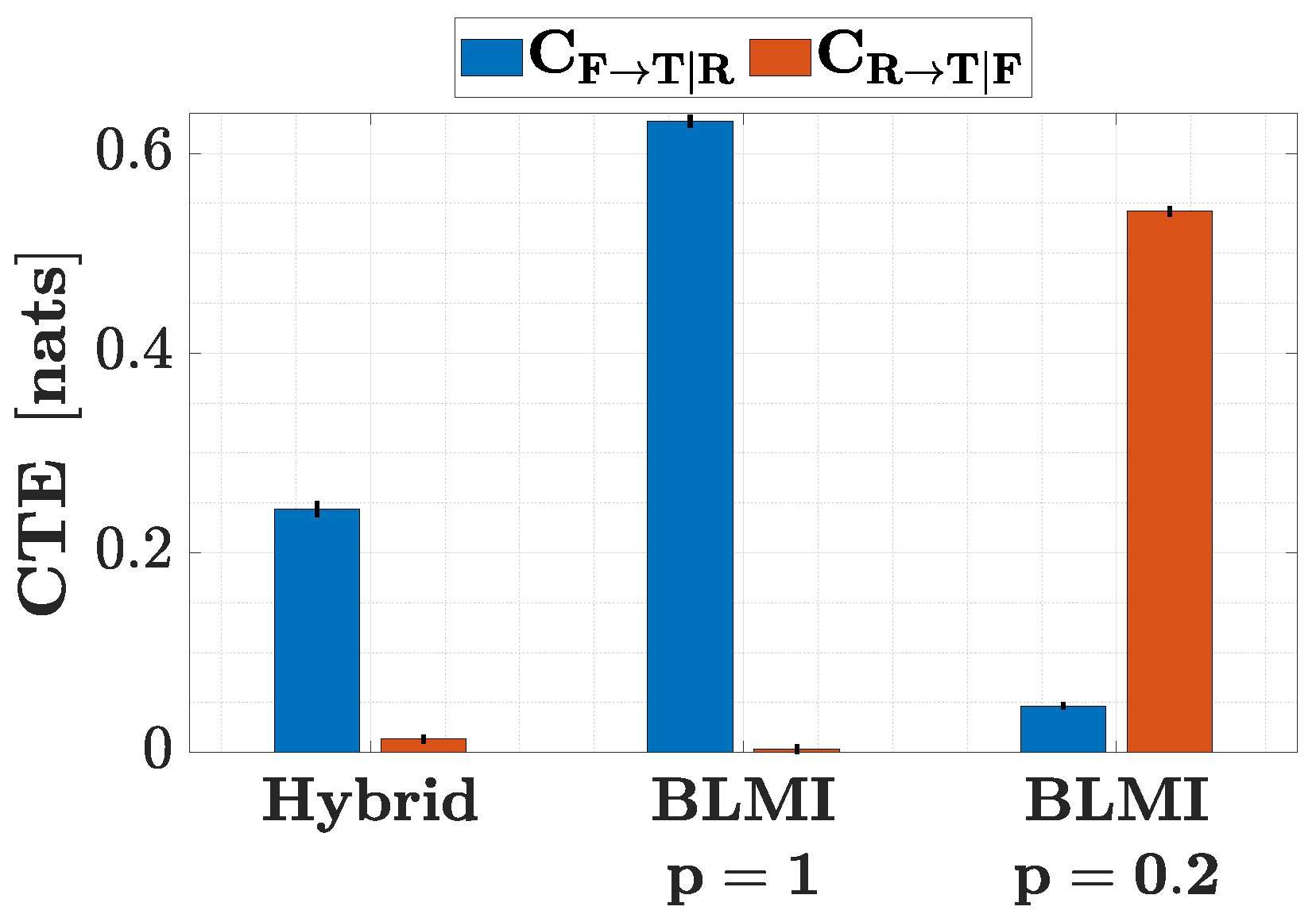
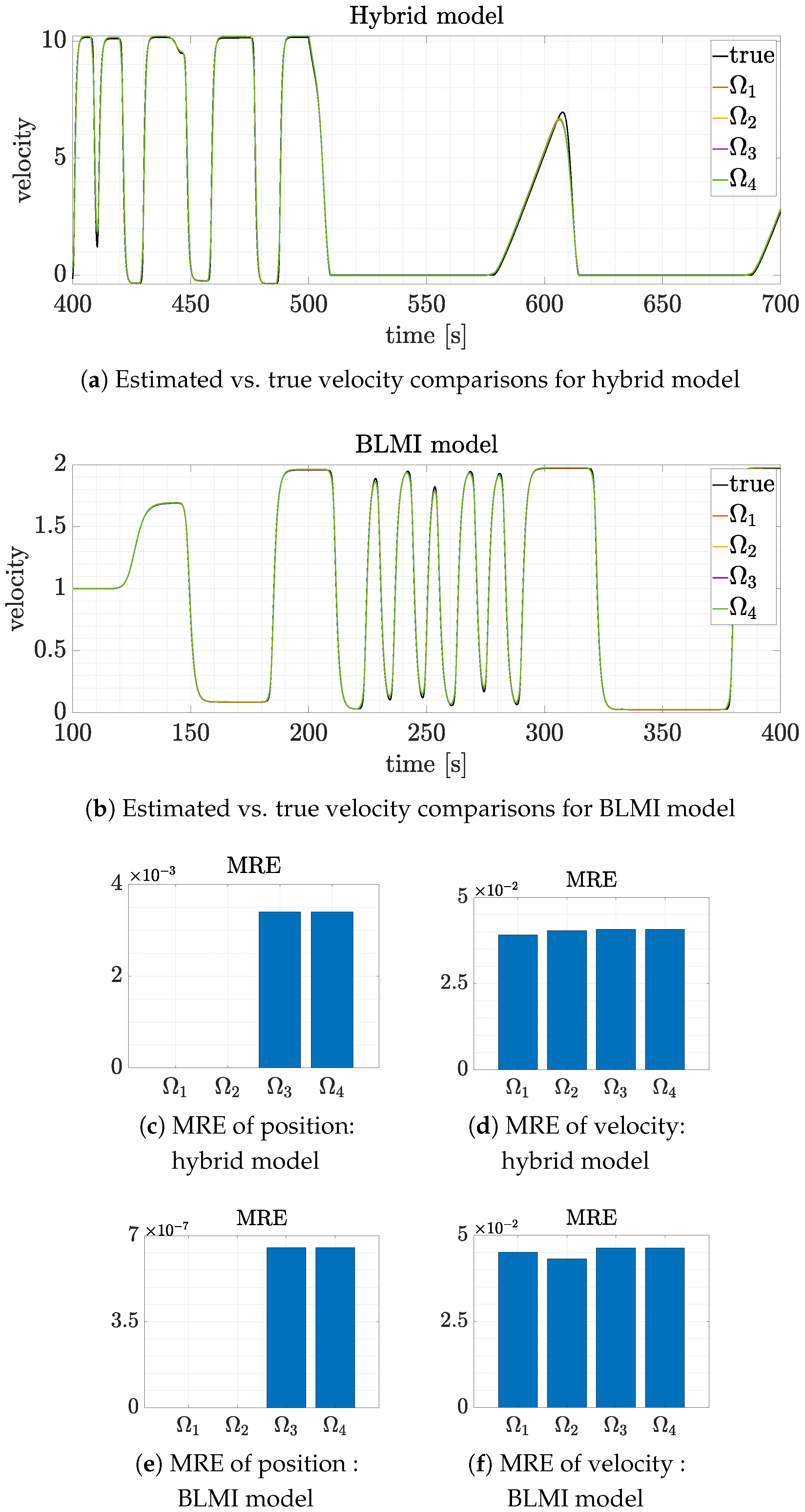
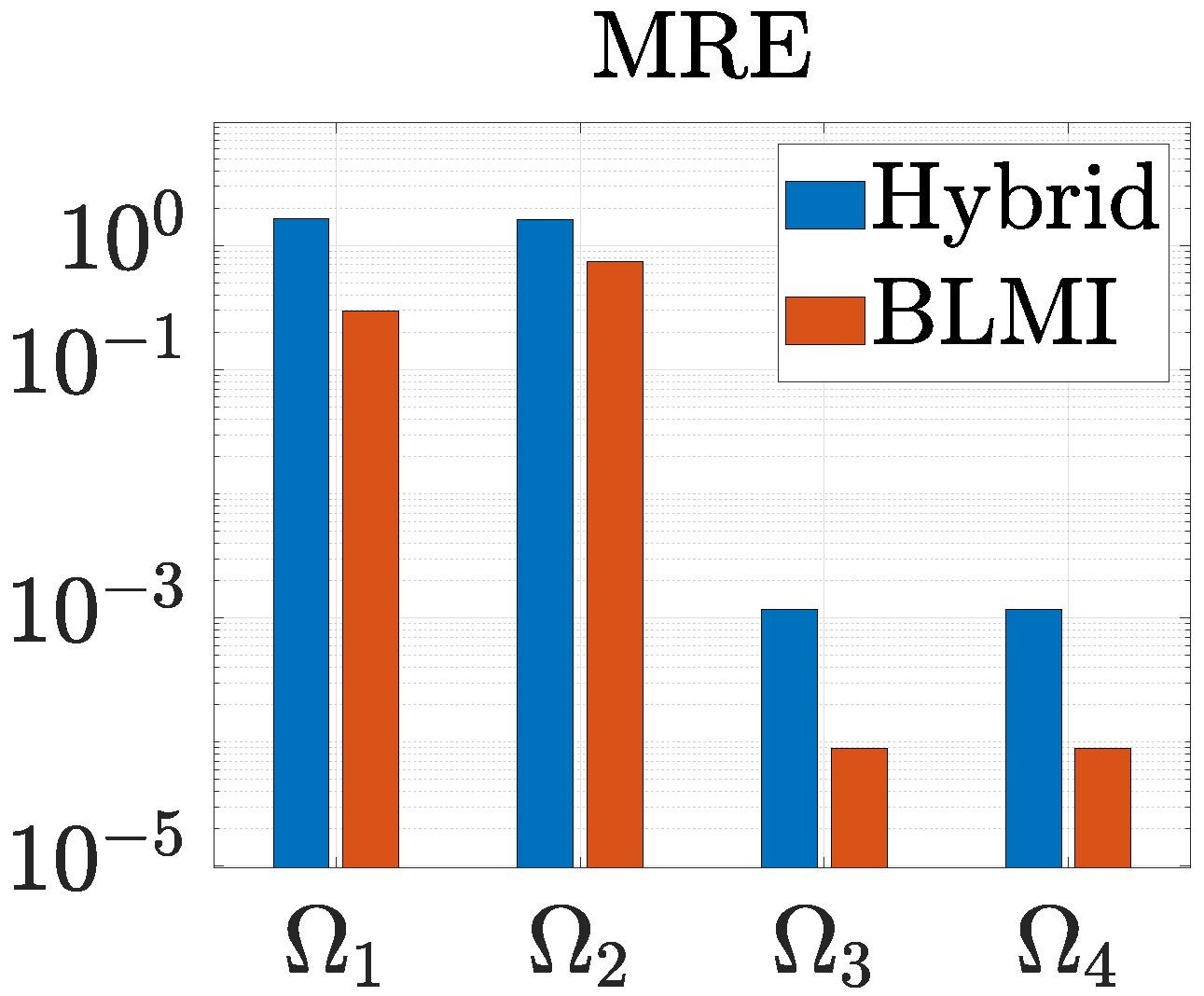

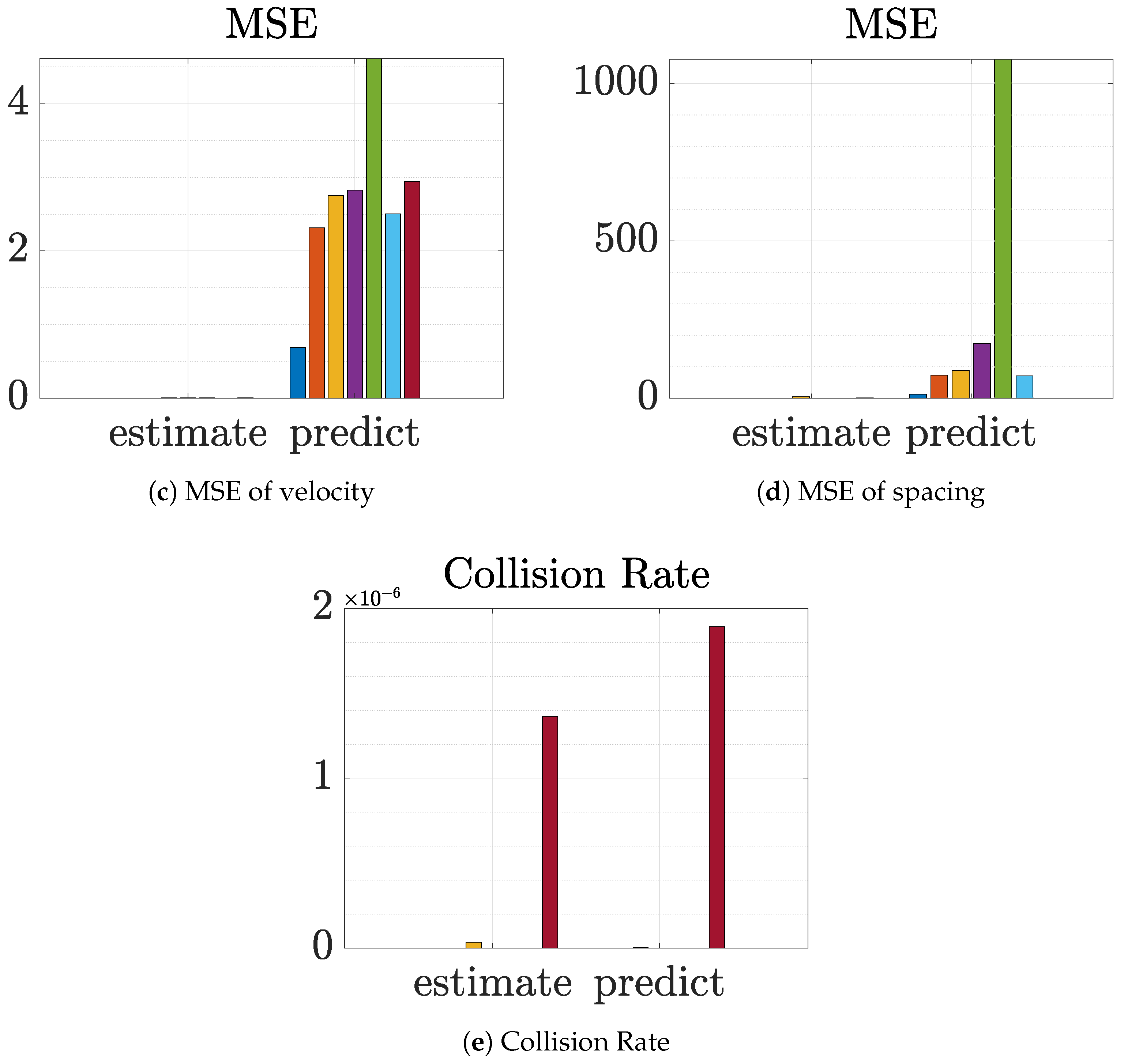
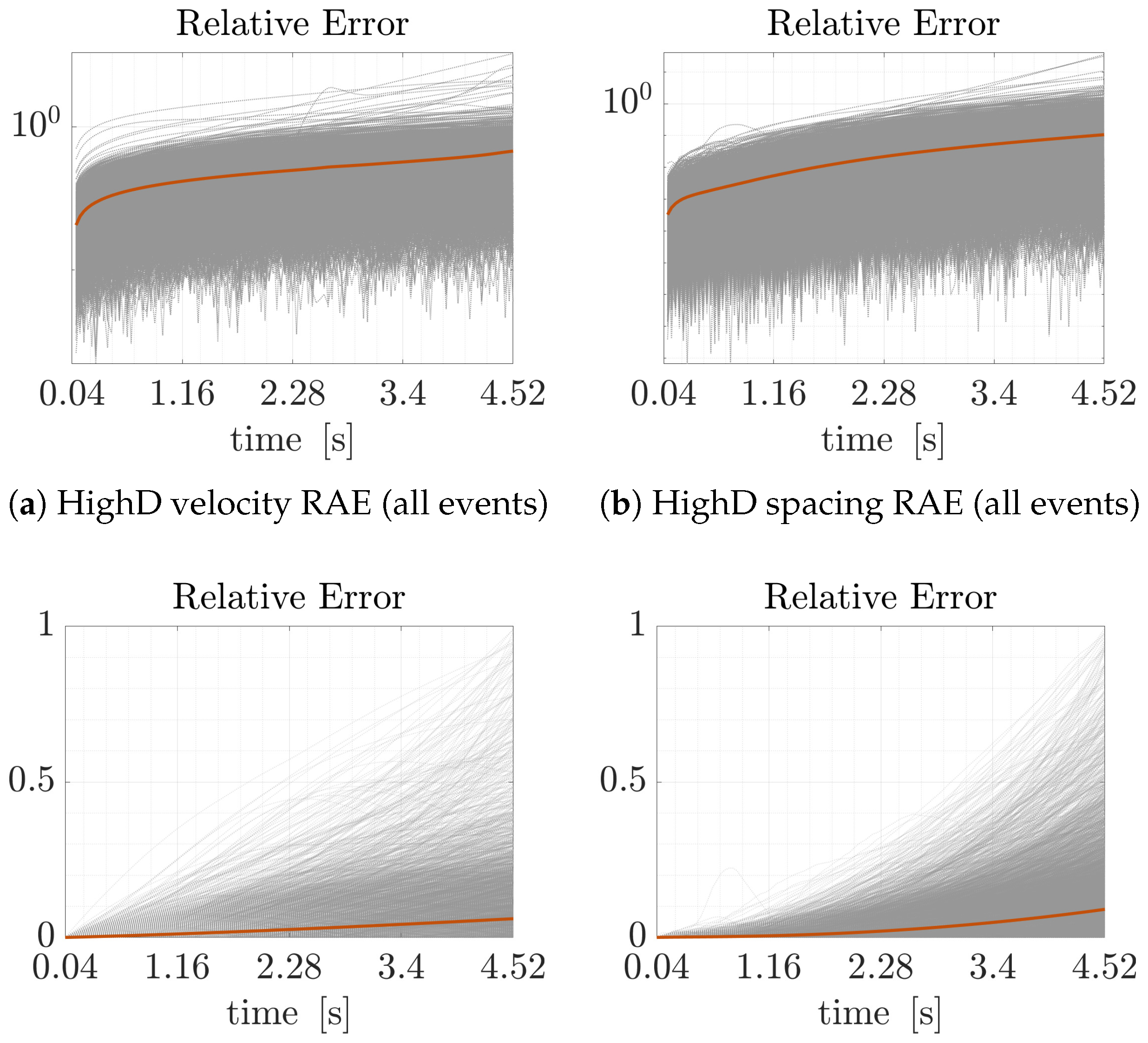
| (a) BLMI model simulation parameters | |||
| Parameter | Value | ||
| number of vehicles | N | 100 | |
| simulation time step (s) | 0.1 | ||
| simulation time (s) | 5000 | ||
| track length (m) | 400 | ||
| BLMI | |||
| Parameter | Value | ||
| 0.8 | |||
| m | 1 | ||
| 0 | |||
| p | |||
| 4 | |||
| 2 | |||
| 2 | |||
| (b) Hybrid model simulation parameters | |||
| Parameter | Value | ||
| number of vehicles | N | 30 | |
| simulation time step (s) | 0.01 | ||
| simulation time (s) | 2500 | ||
| track radius (km) | 50 | ||
| OVM | IDM | ||
| Parameter | Value | Parameter | Value |
| 1.8 | 0.3 | ||
| 5.5 | 30 | ||
| 0.37 | 4 | ||
| 9.1 | 2 | ||
| 4.9 | 1.5 | ||
| b | 3 | ||
| 5 | |||
| (a) Estimation | |||
| Dataset | # events | # valid events | % valid events |
| HighD | 12,541 | 12,540 | 99.992 |
| HighD30 | 1319 | 1300 | 98.559 |
| Lyft | 24,093 | 21,910 | 90.939 |
| NGSIM | 1930 | 1779 | 92.176 |
| SPMD-das1 | 16,658 | 16,658 | 100 |
| SPMD-das2 | 24,247 | 24,246 | 99.996 |
| Waymo | 1440 | 848 | 58.889 |
| (b) Prediction | |||
| Dataset | # events | # valid events | % valid events |
| HighD | 12,541 | 12,468 | 99.418 |
| HighD30 | 1319 | 1208 | 91.585 |
| Lyft | 24,093 | 20,019 | 83.091 |
| NGSIM | 1930 | 1693 | 87.720 |
| SPMD-das1 | 16,658 | 15,669 | 94.063 |
| SPMD-das2 | 24,247 | 23,548 | 97.117 |
| Waymo | 1440 | 726 | 50.417 |
Disclaimer/Publisher’s Note: The statements, opinions and data contained in all publications are solely those of the individual author(s) and contributor(s) and not of MDPI and/or the editor(s). MDPI and/or the editor(s) disclaim responsibility for any injury to people or property resulting from any ideas, methods, instructions or products referred to in the content. |
© 2025 by the authors. Licensee MDPI, Basel, Switzerland. This article is an open access article distributed under the terms and conditions of the Creative Commons Attribution (CC BY) license (https://creativecommons.org/licenses/by/4.0/).
Share and Cite
Ramlall, P.; Roy, S. A Data-Driven Framework for Modeling Car-Following Behavior Using Conditional Transfer Entropy and Dynamic Mode Decomposition. Appl. Sci. 2025, 15, 9700. https://doi.org/10.3390/app15179700
Ramlall P, Roy S. A Data-Driven Framework for Modeling Car-Following Behavior Using Conditional Transfer Entropy and Dynamic Mode Decomposition. Applied Sciences. 2025; 15(17):9700. https://doi.org/10.3390/app15179700
Chicago/Turabian StyleRamlall, Poorendra, and Subhradeep Roy. 2025. "A Data-Driven Framework for Modeling Car-Following Behavior Using Conditional Transfer Entropy and Dynamic Mode Decomposition" Applied Sciences 15, no. 17: 9700. https://doi.org/10.3390/app15179700
APA StyleRamlall, P., & Roy, S. (2025). A Data-Driven Framework for Modeling Car-Following Behavior Using Conditional Transfer Entropy and Dynamic Mode Decomposition. Applied Sciences, 15(17), 9700. https://doi.org/10.3390/app15179700







